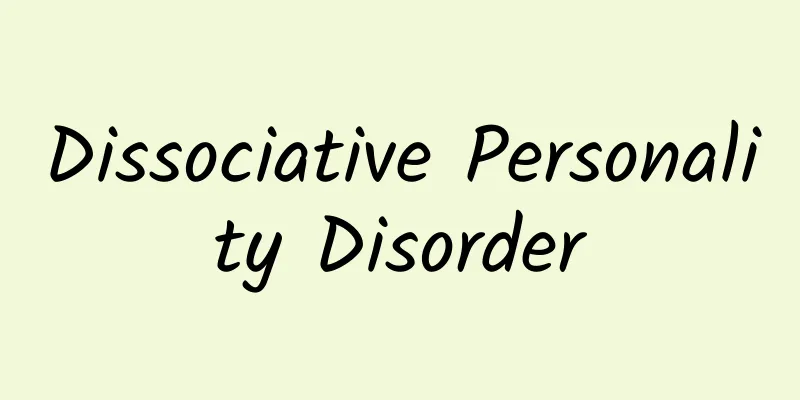Dissociative Personality Disorder

|
Dissociative personality disorder is also known as dissociative disorder, formerly known as hysteria. It is generally a mental disorder caused by mental factors, and some patients will show physical symptoms. The situation of dissociative personality disorder is very complicated. We can start with its causes and symptoms to understand it. Once a similar situation is found, timely treatment is needed and active prevention of recurrence of the disease is required. Causes 1. Psychological factors An individual's experience and response to stressful life events are important factors in triggering this disease. Traumatic experiences in childhood may also be an important cause of dissociative conversion disorder in adulthood. Patients with this disease often have some common personality traits, including: suggestibility, histrionics, egocentrism, emotionality, fantasy, etc. 2. Socio-cultural factors: Patients with this disease have a relatively low level of education and most of them live in a closed homologous cultural environment. Therefore, educational level, social culture, and living environment play an important role in the occurrence of separation and conversion disorder. 3. Biological factors The results of genetic studies on separation conversion disorder are inconsistent. Some studies have found a higher prevalence of dissociative conversion disorder in first-degree relatives of patients with the disorder. But some studies have reached the opposite conclusion. Some scholars believe that this disease is a multifactorial genetic disease. Clinical manifestations 1. Common clinical manifestations (1) Dissociative amnesia is characterized by the sudden inability to recall important events, characterized by the loss of recent stage memory, which can be partial or selective, and generally revolves around traumatic events. This amnesia is not due to organic causes and cannot be explained by general forgetfulness or fatigue. (2) Dissociative fugue refers to the patient suddenly running away from home or workplace while awake, often leaving an intolerable environment and wandering without plan or purpose. At this time, the patient's consciousness range is reduced, but he can carry out basic daily life and simple social contact. Some patients forget their past experiences and emerge with a new identity. Roaming can last from tens of minutes to several days, and some can last longer. This type of attack occurs suddenly and stops suddenly, and the patient cannot fully recall his or her experience during the illness after waking up. (3) The behavior of patients with dissociative stupor meets the criteria for stupor, and examination reveals no evidence of physical illness. Usually after certain life events, the patient remains in a fixed posture for a considerable period of time, has little or no response to external stimuli, and has no or almost no speech and spontaneous purposeful movements. However, the patient's muscle tone and respiratory movements are still present, and sometimes the eyes may be opened and coordinated with the eyeballs. (4) Trance and possession disorders are characterized by a temporary loss of both personal identity and complete awareness of one's surroundings. The patient's scope of consciousness is significantly reduced, and his attention and awareness are limited to or focused on one or two aspects of the closely connected environment, and he only responds to individual stimuli in the environment. There is often a restricted and repetitive series of movements, postures, and pronunciations. If the patient's identity is replaced by a ghost, spirit, or dead person, it is called dissociative possession disorder. After the attack, the patient will forget all or part of the process. (5) Dissociative movement disorder is characterized by complete or partial loss of movement of one or more limbs. Common forms include limb paralysis, limb tremor, twitching or myoclonus, inability to stand or walk, aphonia, etc. Paralysis can be partial, meaning decreased or slowed movements, or complete. Ataxia can occur in various forms and degrees, especially in the legs, causing odd postures or inability to stand without assistance. There may also be exaggerated tremors in one or more extremities or throughout the body. (6) Dissociative convulsions Dissociative convulsions (pseudo-seizures) are a state similar to an epileptic seizure, but without the clinical features of epilepsy and electrophysiological changes. Tongue biting, severe falls, urinary incontinence, etc. are rare in dissociative convulsions. There is no loss of consciousness, but instead stupor or trance. (7) Dissociative sensory disorders may manifest as numbness, loss, hypersensitivity or abnormality of body sensation, or other specific sensory disorders. The boundaries of the area of skin numbness suggest that it is closer to the patient's concept of somatic function than to neuroanatomy. Sensory loss may be accompanied by complaints of paresthesias. Visual impairment often manifests as loss of visual acuity, blurred vision, or "tunnel vision." It often occurs suddenly, but can also return to normal suddenly after treatment. Although the patient complained of visual loss, his overall mobility and motor performance were remarkably intact. Hearing impairment often manifests as sudden hearing loss, and related hearing function tests often show normal results. "Hysterical ball" refers to the subjective feeling of having some inexplicable thing or mass at the level of the cricoid cartilage at the bottom of the pharynx, causing discomfort such as fullness, pressure or obstruction. Chinese medicine calls it "plum pit qi". Relevant medical examinations cannot reveal organic abnormalities that match the symptoms. (8) Other dissociative conversion disorders ①Ganser syndrome is a special type of dissociative conversion disorder, which is more common in detained prisoners. It is characterized by being able to understand questions but often giving "approximate answers", often accompanied by several other dissociative symptoms, and the background of its occurrence suggests the existence of psychological reasons. ② Multiple personality disorder, also known as dissociative identity disorder, is characterized by the same individual having two or more completely different personalities, but at a certain time, only one of them is obvious. Each personality is complete, with its own memories, behaviors, preferences, and can be completely opposite to the single pre-morbid personality. A relatively common form is dual personality, in which one is usually dominant, but neither personality has access to the other's memory and is almost unaware of the other's existence. The transition from one personality to another is usually sudden at first and closely associated with a traumatic event; thereafter, it generally occurs only in response to a major or stressful event or in response to relaxation, hypnosis, or catharsis therapy. (9) Mixed dissociative conversion disorder refers to a mixed form of the above-mentioned forms of dissociative conversion disorder. 2. Special manifestations (1) Collective dissociative disorder refers to the collective onset of dissociative disorder, which often occurs in areas with relatively backward economy and culture and more feudal superstitious activities. At the beginning, one person becomes ill, and the people around them are influenced by it and, through self-suggestion and mutual suggestion, they develop symptoms similar to those of the first patient in a short period of time. These patients often have common living backgrounds and cultural concepts, and the majority are women. (2) Compensatory neurosis refers to the tendency of victims to display, exaggerate or withhold symptoms in incidents involving compensation, such as work-related injuries, traffic accidents, and medical disputes. Symptoms can last a long time. However, the persistence of this symptom may be due to the patient's subconscious mechanism rather than intentional action by the patient. (3) Occupational neurosis refers to the symptoms of patients that are closely related to their occupational activities, mainly manifested as motor coordination disorders, such as writer's cramps, dancers' lower limb movement disorders before performances, and teachers' loss of voice before going to the podium. (4) Dissociative psychosis occurs suddenly after a stressful event, and is characterized by confusion, wandering, disordered behavior, and recurring fantasy life plots, which may be caused by fragmentary hallucinations and delusions. Patients are often indifferent to their illness or do not consider themselves ill. The course of the disease usually lasts for several weeks, often with sudden onset and sudden stop, and is prone to recurrence. |
<<: Antisocial personality disorder
>>: Anxious personality disorder
Recommend
Are hemorrhoids serious?
Hemorrhoids, an anal disease, should torment many...
What to do if your gums are swollen and painful
The problem of red and swollen gums can be said t...
What can't you eat if your progesterone level is low?
If a pregnant woman has low progesterone during p...
What are the early symptoms of nephritis in women?
Hypertension"text-indent: 2em;">Many ...
Can a one-year-old baby drink zinc gluconate oral solution?
Generally speaking, as long as the baby is over t...
What to do if uric acid is high in physical examination
Uric acid is an indicator of human kidney functio...
What are the effects and functions of Danshen?
Salvia miltiorrhiza is also a common Chinese medi...
28 weeks hard belly
Watching their bellies grow day by day, many preg...
Will tuberculosis recur?
Tuberculosis is a common lung disease, but many p...
What to do if you are in sub-health
Physical health requires attention in all aspects...
What causes Down syndrome high risk
Many pregnant mothers will undergo Down syndrome ...
Complications of ovariohysterectomy
After the ovarian and hysterectomy surgery, the p...
How to treat eye floaters
Eye floaters are more common in summer, mainly be...
In what situations can autohemotherapy not be used?
In our lives, there are some novel therapies in t...
What is the best food for the elderly to treat cough and asthma?
The physical constitution of the elderly is relat...









